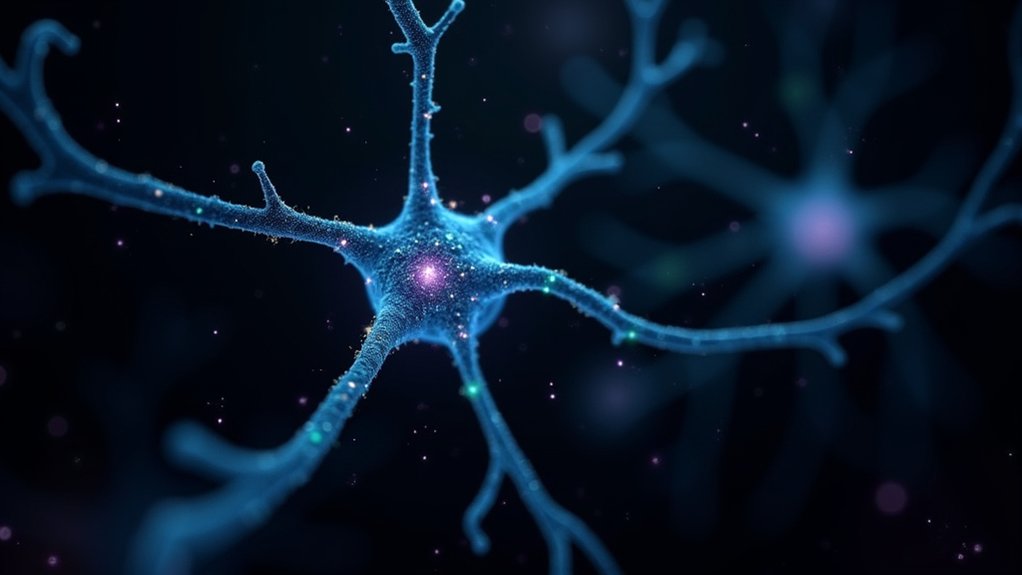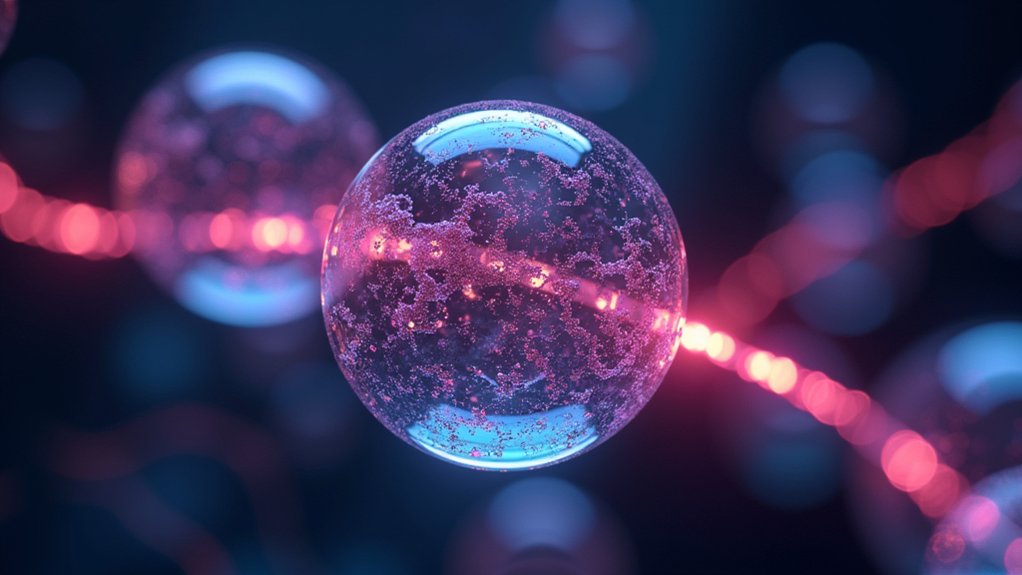Nitrous oxide blocks your pain signals through multiple mechanisms in your nervous system. It primarily suppresses pain by blocking NMDA receptors, enhancing GABA-mediated inhibition, and triggering endorphin release in your brain’s periaqueductal grey area. You’ll experience rapid pain relief as N2O disrupts pain transmission at your spinal cord level while activating your body’s natural opioid system. Understanding these complex neural pathways reveals why this analgesic approach proves so effective.
The Science Behind N2O’s Pain-Blocking Effects

While nitrous oxide (N2O) has been used clinically for over 150 years, its complex mechanisms of pain suppression involve multiple neural pathways beyond the well-known opioid system. The gas works through several key mechanisms: it blocks NMDA receptors to reduce glutamate’s pain-signaling effects, enhances GABA-mediated inhibition to decrease neuronal excitability, and disrupts pain transmission at the spinal cord level. When administered, opioid peptides are released in the midbrain’s periaqueductal grey area, triggering a cascade of pain-blocking effects. The rapid onset of action allows for immediate sedation effects once inhalation begins.
The gas’s effectiveness stems from its unique ability to engage in midbrain non-opioid modulation while creating synergistic neurotransmitter effects across multiple systems. When these mechanisms work together, they produce powerful antinociceptive results through simultaneous inhibition of excitatory pathways and enhancement of inhibitory circuits. This multi-targeted approach explains why N2O remains a valuable tool in pain management despite its long history. Patients can easily control their own level of comfort since the gas mixture is self-administered through inhalation.
Key Mechanisms in the Opioid System
When you examine nitrous oxide’s interaction with the opioid system, you’ll find it primarily stimulates μ-opioid receptors to trigger endogenous endorphin release in the central nervous system. Similar to morphine, nitrous oxide causes a feeling of euphoria in patients during administration.
Your body’s natural opioid pathways become activated as N2O molecules bind to specific receptor sites in the periaqueductal gray and descending pain modulatory circuits. The resulting cascade amplifies endorphin signaling through both ascending and descending pain pathways, creating a robust analgesic effect through the coordinated activation of multiple opioid receptor subtypes. This interaction reflects how G protein-coupled receptors respond to signals by reducing neurotransmission, ultimately contributing to pain relief. The sustained pain-blocking effects are mediated through protein kinase C pathways that maintain long-lasting inhibition of nociceptor activity.
Endorphin Release Pathways
The endogenous opioid system operates through a complex network of endorphin release pathways that modulate pain perception at multiple levels. When you experience physical or psychological stress, POMC processing dynamics in your hypothalamus accelerate, triggering the release of beta-endorphins. These endogenous opioids then engage in beta-endorphin receptor signaling at both central and peripheral sites. Additionally, immune cells store beta-endorphins within specialized secretory granules, ready for release during inflammatory responses.
Your body’s pain modulation occurs through multiple mechanisms: beta-endorphins bind to peripheral opioid receptors on nociceptive nerve fibers, while simultaneously acting on receptors in your brainstem and spinal cord. This dual action enhances analgesic effects through both ascending and descending pain pathways. The release of beta-endorphins activates ε-opioid receptors which facilitate a descending enkephalinergic pathway for pain control. However, chronic stress or extended opioid exposure can downregulate your POMC production, diminishing your natural pain-relief capacity over time.
Opioid Receptor Binding Sites
Understanding opioid receptor binding mechanisms requires examination of key molecular interactions at μ-opioid receptor (mOR) sites. You’ll find that critical amino acid residues, particularly Asp147 and His297, form essential binding contacts through salt bridges and hydrogen bonds with both endogenous and synthetic ligands. Studies reveal that fentanyl can establish dual binding modes through interactions with both Asp147 and His297 residues. G protein coupling occurs when ligand binding at the orthosteric site induces receptor activation. Computational drug design methods have revealed novel opioid receptor ligands with biased signaling properties.
Ligand-induced receptor conformations vary depending on the binding molecule. When agonists like DAMGO or endomorphins interact with mOR, they trigger distinct conformational changes between TM3 and TM6 domains. These structural shifts are further modulated by allosteric sodium binding sites within the receptor cavity. You’ll notice that sodium ions compete with ligands for access, influencing receptor activity and signaling pathways. This complex interplay determines whether the receptor adopts an active or inactive state, ultimately controlling pain signal transmission.
Role of GABA Pathways in Pain Suppression

Your body’s GABA pathways form a critical inhibitory network that suppresses pain signals through specialized receptors in the spinal cord and brain.
Recent research shows that primary afferent depolarization caused by GABA receptor activation helps inhibit peripheral pain input to the spinal cord. When GABA receptors activate, particularly GABA_A channels in the dorsal horn, they create a chloride-dependent inhibition that effectively blocks incoming nociceptive transmission.
This GABAergic system connects closely with sedative effects, as compounds that enhance GABA signaling often produce both analgesia and sedation through overlapping neural circuits. Different types of GABA receptors contribute to pain control through fast neurotransmission pathways. The endogenous analgesia system utilizes multiple inhibitory neurotransmitters to regulate pain processing in the nervous system.
GABA Receptor Pain Control
When examining pain suppression mechanisms, GABA receptor pathways emerge as essential mediators through both fast-acting ionotropic (GABA_A) and slower metabotropic (GABA_B) signaling cascades. You’ll find that GABAergic synapse modulation occurs through multiple mechanisms, while GABA receptor upregulation enhances pain control efficacy. These pathways originate from brainstem neurons that send inhibitory signals directly to the spinal cord. GABAergic signaling in the ventrolateral periaqueductal gray demonstrates pronociceptive effects that influence pain processing.
| Receptor Type | Action Mechanism | Pain Control Effect |
|---|---|---|
| GABA_A | Fast ionotropic | Rapid neuronal inhibition |
| GABA_B | Slow metabotropic | Prolonged suppression |
| Presynaptic | Neurotransmitter reduction | Nociceptive blocking |
| Postsynaptic | Hyperpolarization | Signal dampening |
The system works through dual mechanisms: presynaptic inhibition reduces neurotransmitter release, while postsynaptic effects generate hyperpolarization. This combined action creates robust pain suppression through direct limitation of nociceptive signaling and enhanced inhibitory potentials in pain-processing neural circuits.
Spinal Inhibitory Mechanisms
Three primary spinal inhibitory mechanisms orchestrate GABA-mediated pain suppression through distinct neuroanatomical pathways. First, you’ll find spinal GABAergic inhibition operating through GABA-A receptors in the dorsal horn, functioning as vital gatekeepers that modulate incoming nociceptive signals.
Second, descending pathways from the PAG-RVM system enhance this inhibitory control through GABA disinhibition, where opioids and cannabinoids suppress GABAergic inputs to amplify pain suppression.
Third, dorsal root ganglion neurons utilize specialized GABA-A receptor subunits, particularly α5, to regulate peripheral pain transmission. You’ll notice these mechanisms work synergistically, though chronic pain conditions can disrupt their function.
Understanding these pathways reveals why maintaining robust spinal GABAergic inhibition is pivotal for effective dorsal horn pain gating and therapeutic intervention.
Sedation-Pain Relief Connection
Building on our understanding of spinal inhibitory mechanisms, the relationship between sedation and pain relief illuminates complex GABAergic pathways in the central nervous system. You’ll find that GABA-mediated neurotransmitter synergy plays an essential role in descending pain pathways, particularly through the PAG-RVM circuit.
When examining sedative effects, you’re observing a sophisticated interplay between GABA receptor subtypes. GABA-A receptors drive rapid synaptic inhibition, while GABA-B receptors maintain tonic modulation of neural activity. This dual action creates a coordinated response where cannabinoid and opioid systems work together to enhance pain suppression. Through disinhibition, these compounds reduce GABA release from interneurons, effectively lifting the brake on analgesic mechanisms. Understanding this relationship helps explain why sedative effects often accompany pain relief in clinical applications.
NMDA Receptor Blockade and Pain Management

Several breakthrough studies have demonstrated that NMDA receptor blockade plays a pivotal role in managing chronic pain conditions through its disruption of central sensitization mechanisms. Research shows that targeted NMDAR inhibition effectively combats NMDA receptor hyperactivity, which drives neuropathic pain and reduces opioid efficacy.
NMDA receptor blockade disrupts central sensitization pathways, providing a crucial mechanism for managing chronic pain and improving opioid effectiveness.
Key findings on NMDAR blockade mechanisms:
- Disrupts α2δ-1 interactions with presynaptic NMDARs, reducing abnormal glutamate release
- Normalizes nerve injury-induced synaptic plasticity through selective Src kinase inhibition
- Decreases miniature excitatory postsynaptic current frequency in affected neural pathways
- Targets upregulated receptors while preserving basal NMDAR function
These mechanisms explain why NMDAR antagonists effectively reduce tactile allodynia and cold hypersensitivity in neuropathic pain models, though clinical applications require careful consideration of cognitive side effects.
Neurotransmitter Interactions and Pain Control
The molecular basis of nitrous oxide’s analgesic effects extends beyond NMDA receptor antagonism to encompass complex neurotransmitter interactions. When you’re exposed to nitrous oxide, it triggers opioid peptide release in your brainstem, specifically activating descending noradrenergic pathways that modulate pain signals.
You’ll find this mechanism works through a dual system: first, the release of endogenous opioids stimulates mu-receptors, and second, the activation of noradrenergic neurons enhances pain inhibition. These pathways work in concert with descending serotonergic pathways and descending inhibitory interneurons to create an extensive pain control network.
The synergistic interaction between nitrous oxide-induced opioid release and noradrenergic activation provides robust analgesia, making it particularly effective for acute pain management.
Multiple Ion Channel Effects
Five distinct ion channel interactions form the foundation of nitrous oxide’s complex analgesic mechanism. These carefully orchestrated effects create a multi-targeted approach to pain signal disruption, demonstrating remarkable efficacy in clinical applications.
Nitrous oxide’s pain-relieving power stems from multiple synchronized ion channel effects, creating a sophisticated network of analgesic activity.
- You’ll find NMDA receptor blockade serves as the primary mechanism, preventing calcium influx and suppressing central sensitization through direct inhibition of receptor-mediated currents.
- The drug enhances inhibitory neurotransmission by potentiating GABA and glycine receptors, while simultaneously providing calcium channel modulation.
- Through activation of two-pore-domain potassium channels, you get membrane hyperpolarization that reduces neuronal excitability and stabilizes pain thresholds.
- Beyond sodium channel inhibition, nitrous oxide exhibits broad-spectrum effects on ligand-gated channels, including AMPA, kainate, and nicotinic acetylcholine receptors, contributing to its extensive analgesic profile.
Clinical Applications and Pain Relief
Clinical applications of nitrous oxide demonstrate robust efficacy across diverse medical scenarios, particularly in pain management protocols where rapid onset and controlled administration are crucial. You’ll find significant applications in midwifery settings, where self-administered control enables effective labor pain management without compromising maternal consciousness or fetal safety.
| Setting | Primary Use | Key Advantage |
|---|---|---|
| Labor & Delivery | Contraction pain | Self-administration |
| EMS Response | Trauma management | Rapid onset |
| Gynecological Procedures | Minimally invasive surgery | Quick recovery |
The analgesic properties prove especially valuable in gynecological procedures, where its anxiolytic effects enhance patient tolerance. Its mechanism mirrors opioid pathways at spinal cord levels, yet offers distinct advantages through GABA and NMDA receptor modulation. This multi-modal action enables effective pain control while maintaining patient consciousness and coordination.
Risk Factors and Safety Profile
While nitrous oxide maintains an established safety record in clinical settings, several key risk factors warrant careful consideration during administration. Strict regulatory oversight governs its medical usage, requiring proper storage precautions in medical-grade gas canisters to safeguard against contamination and protect patient safety.
The gas supports combustion despite being non-flammable, necessitating proper handling protocols and fire safety measures in clinical environments.
Medical facilities must implement exhaled breath capture systems and adequate ventilation to minimize staff exposure to residual gas.
Post-procedure oxygen flushing protocols effectively clear remaining nitrous oxide from delivery systems.
Storage requirements include temperature-controlled environments, secure containment systems, and regular monitoring of gas purity levels.
These safety measures, combined with proper clinical protocols, help maintain the established safety profile of nitrous oxide in medical settings.
Frequently Asked Questions
Can Nitrous Oxide Be Used Safely During Pregnancy?
While you can safely use nitrous oxide during pregnancy under medical supervision, it’s vital to weigh both maternal health considerations and potential fetal development impact.
Research indicates short-term exposure poses minimal risks when administered by professionals, particularly during dental procedures. You’ll need a thorough risk-benefit assessment, and it’s recommended during the second trimester.
However, you should avoid it if you have B12 deficiency, as this could affect fetal development.
How Long Should Patients Wait to Drive After Receiving Nitrous Oxide?
You’ll typically need 5-10 minutes for the initial sedative effects to wear off after discontinuing nitrous oxide. While some patients can drive immediately, post-procedure recovery time varies based on dosage considerations and individual response.
Wait at least 15-30 minutes before driving to guarantee your reflexes and cognitive functions return to normal. Your dentist will assess your alertness and may recommend longer waiting periods depending on the specific dosage administered and your personal response.
Does Eating Before Nitrous Oxide Administration Affect Its Effectiveness?
While research specifically addressing the relationship between food intake amount and nitrous oxide effectiveness is limited, it’s recommended you follow your healthcare provider’s fasting duration guidelines.
Unlike general anesthesia, which typically requires 6-8 hours of fasting, nitrous oxide sedation doesn’t always demand strict fasting protocols. However, you’ll want to avoid heavy meals shortly before treatment, as they could affect your comfort and potentially influence the sedation experience.
Can Nitrous Oxide Interact With Prescription Antidepressants or Anxiety Medications?
You’ll need to discuss medication interactions with your healthcare provider, as N2O can interact with certain antidepressants and anxiety medications.
Research indicates potential concerns with benzodiazepines due to overlapping GABAergic effects, and MAOIs or SNRIs due to noradrenergic pathway interactions. While no severe contraindications exist with most SSRIs, proper prescription management is essential.
Your doctor should review your current medications and adjust your treatment plan accordingly.
What Age Restrictions Exist for Nitrous Oxide Use in Dental Procedures?
While there aren’t strict age limits for nitrous oxide in dental procedures, you’ll need to meet specific criteria for safe administration. Dosage requirements vary based on your weight and individual response.
You can receive nitrous oxide at any age if you’re healthy, though practitioners will adjust concentrations carefully for pediatric patients. You’ll need proper monitoring regardless of age, and your dentist must follow professional guidelines limiting concentrations to ≤70% for safety.

